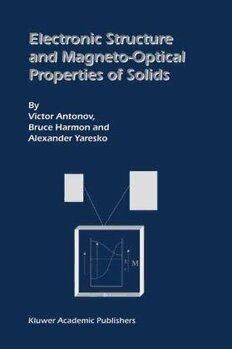
Electronic structure and magneto-optical properties of solids PDF
Preview Electronic structure and magneto-optical properties of solids
ELECTRONIC STRUCTURE AND MAGNETO-OPTICAL PROPERTIES OF SOLIDS This page intentionally left blank Electronic Structure and Magneto-Optical Properties of Solids by Victor Antonov Institute of Metal Physics, Kiev, Ukraine Bruce Harmon Ames Laboratory, Iowa State University, Iowa, U.S.A. and Alexander Yaresko Max-Planck Institute for the Chemical Physics of Solids, Dresden, Germany KLUWER ACADEMIC PUBLISHERS NEW YORK, BOSTON, DORDRECHT, LONDON, MOSCOW eBook ISBN: 1-4020-1906-8 Print ISBN: 1-4020-1905-X ©2004 Kluwer Academic Publishers New York, Boston, Dordrecht, London, Moscow Print ©2004 Kluwer Academic Publishers Dordrecht All rights reserved No part of this eBook may be reproduced or transmitted in any form or by any means, electronic, mechanical, recording, or otherwise, without written consent from the Publisher Created in the United States of America Visit Kluwer Online at: http://kluweronline.com and Kluwer's eBookstore at: http://ebooks.kluweronline.com Contents Preface ix Acknowledgments xv 1. THEORETICAL FRAMEWORK 1 1.1 Density Functional Theory (DFT) 4 1.1.1 Formalism 4 1.1.2 Local Density Approximation 6 1.2 Modifications of local density approximation 8 1.2.1 Approximations based on an exact equation for E 9 xc 1.2.2 Gradient correction 10 1.2.3 Self-interaction correction 12 1.2.4 LDA+U method 15 1.2.5 Orbital polarization correction 23 1.3 Excitations in crystals 26 1.3.1 Landau Theory of the Fermi Liquid 26 1.3.2 Green’s functions of electrons in metals 30 1.3.3 The GW approximation 33 1.3.4 Dynamical Mean-Field Theory (DMFT) 35 1.4 Magneto-optical effects 39 1.4.1 Classical optics 40 1.4.2 MO effects 48 1.4.3 Linear-response theory 61 1.4.4 Optical matrix elements 67 2. MAGNETO-OPTICAL PROPERTIES OF d FERROMAGNETIC MATERIALS 71 2.1 Transition metals and compounds 71 2.1.1 Ferromagnetic metals Fe, Co, Ni 71 vi ELECTRONIC STRUCTURE AND MO PROPERTIES OF SOLIDS 2.1.2 Paramagnetic metals Pd and Pt 75 2.1.3 CoPt alloys 99 2.1.4 XPt3 compounds (X=V, Cr, Mn, Fe and Co) 121 2.1.5 Heusler Alloys 127 2.1.6 MnBi 135 2.1.7 Chromium spinel chalcogenides 138 2.1.8 Fe3O4 and Mg2+-, or Al3+ -substituted magnetite 141 2.2 Magneto-optical properties of magnetic multilayers. 158 2.2.1 Magneto-optical properties of Co/Pd systems 159 2.2.2 Magneto-optical properties of Co/Pt multilayers 178 2.2.3 Magneto-optical properties of Co/Cu multilayers 193 2.2.4 Magneto-optical anisotropy in Fe /Au superlattices 203 n n 3. MAGNETO-OPTICAL PROPERTIES OF f FERROMAGNETIC MATERIALS 229 3.1 Lantanide compounds 229 3.1.1 Ce monochalcogenides and monopnictides 230 3.1.2 NdX (X=S, Se, and Te) and Nd3S4 239 3.1.3 Tm monochalcogenides 248 3.1.4 Sm monochalcogenides 265 3.1.5 SmB6 and YbB12 273 3.1.6 Yb compounds 286 3.1.7 La monochalcogenides 308 3.2 Uranium compounds. 320 3.2.1 UFe2 322 3.2.2 U3X4 (X=P, As, Sb, Bi, Se, and Te) 327 3.2.3 UCu2P2, UCuP2, and UCuAs2 332 3.2.4 UAsSe and URhAl 338 3.2.5 UGa2 341 3.2.6 UPd3 346 4. XMCD PROPERTIES OF d AND f FERROMAGNETIC MATERIALS 357 4.1 3d metals and compounds 358 4.1.1 XPt3 Compounds (X=V, Cr, Mn, Fe, Co and Ni). 359 4.1.2 Fe3O4 and Mn-, Co-, or Ni-substituted magnetite. 379 4.2 Rare earth compounds. 395 4.2.1 Gd5(Si2Ge2 compound) 397 4.3 Uranium compounds. 401 4.3.1 UFe2 404 Contents vii 4.3.2 US, USe, and UTe 412 4.3.3 UXAl (X=Co, Rh, and Pt) 420 4.3.4 UPt3 428 4.3.5 URu2Si2 434 4.3.6 UPd2Al3 and UNi2Al3 438 4.3.7 UBe13 444 4.3.8 Conclusions 451 Appendices 453 A Linear Method of MT Orbitals 453 A.1 Atomic Sphere Approximation 453 A.2 MT orbitals 455 A.3 Relativistic KKR–ASA 456 A.4 Linear Method of MT Orbitals (LMTO) 460 A.4.1 Basis functions 460 A.4.2 Hamiltonian and overlap matrices 462 A.4.3 Valence electron wave function in a crystal 463 A.4.4 Density matrix 463 A.5 Relativistic LMTO Method 464 A.6 Relativistic Spin-Polarized LMTO Method 466 A.6.1 Perturbational approach to the relativistic spin-polarized LMTO method 467 B Optical matrix elements 469 B.1 ASA approximation 469 B.2 Combined-correction term. 475 References 477 Index 527 This page intentionally left blank Preface In 1845 Faraday discovered [1] that the polarization vector of linearly po- larized light is rotated upon transmission through a sample that is exposed to a magnetic field parallel to the propagation direction of the light. About 30 years later, Kerr [2] observed that when linearly polarized light is reflected from a magnetic solid, its polarization plane also becomes rotated over a small angle with respect to that of the incident light. This discovery has become known as the magneto-optical (MO) Kerr effect. Since then, many other magneto- optical effects, as for example the Zeeman, Voigt and Cotton-Mouton effects [3], have been discovered. These effects all have in common that they are due to a different interaction of left- and right-hand circularly polarized light with a magnetic solid. The Kerr effect has now been known for more than a century, but it was only in recent times that it became the subject of intensive investiga- tion. The reason for this recent development is twofold: first, the Kerr effect is relevant for modern data storage technology, because it can be used to ‘read’ suitably stored magnetic information in an optical manner [4, 5] and second, the Kerr effect has rapidly developed into an appealing spectroscopic tool in materials research. The technological research on the Kerr effect was initially motivated by the search for good magneto-optical materials that could be used as information storage media. In the course of this research, the Kerr spectra of many ferromagnetic materials were investigated. An overview of the exper- imental and theoretical data collected on the Kerr effect can be found in the review articles by Buschow [6], Reim and Schoenes [7], Schoenes [8], Ebert [9], Antonov et al. [10, 11], and Oppeneer [12]. The quantum mechanical understanding of the Kerr effect began as early as 1932 when Hulme [13] proposed that the Kerr effect could be attributed to spin-orbit (SO) coupling (see, also Kittel[14]). The symmetry between left- and right-hand circularly polarized light is broken due to the SO coupling in a magnetic solid. This leads to different refractive indices for the two kinds of circularly polarized light, so that incident linearly polarized light is reflected
